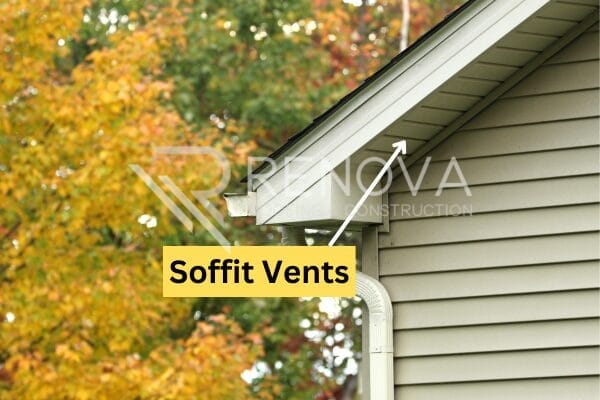Roof vents are, without a doubt, an essential part of every home. These roofing components play a crucial role in maintaining a comfortable indoor environment. But as is the case with roofing materials and siding options, there are several roof vents available on the market.
Today, I’m here to shed light on the importance of these vital (and often unnoticed) features. By understanding roof vents and knowing which ones are right for your home, you can ensure ideal living conditions while preventing costly damage.
Why Is It Important To Install Roof Vents?
The primary purpose of roof vents is to improve ventilation. But before you choose the best type of roof vent, it’s important to know why ventilation is necessary in the first place, i.e., why you should be concerned about having adequate attic ventilation.
Essentially, proper attic ventilation plays a crucial role in regulating temperature extremes and moisture buildup. Incessantly damp environments can promote mold growth, and besides bringing potential health hazards, it can also affect the structural integrity of your house over time. But that’s not all—improper ventilation may even lead to inflated energy bills due to overworking HVAC systems. So essentially, good ventilation goes beyond just keeping the household comfortable—it safeguards your health while promoting efficient energy use.
The Role of Intake and Exhaust Vents in Your Home
Understanding the different types of roof vents is important, as it helps you comprehend how your home breathes. Proper airflow is achieved through a combination of intake and exhaust vents. Intake vents like soffit or eave vents allow fresh air to enter by sitting at lower points of the roof. On the other hand, exhaust vents, like ridge vents, are placed a little higher up on the roof and help to usher out stale, humid air.
Later in this article, we will explore the different types of roof vents available to you. We will also delve into some innovative options that have emerged in this area of home construction.
In essence, there are two main categories that these vents fall under: passive and active.
5 Best Passive Roof Vents
Passive roof vents rely on natural airflow to work, with warm air rising within the attic space being their basic operating principle.
#1 Ridge Vents (With and Without Baffle)
Ridge vents or roof ridge vents are ventilation options that run along the peak of your roofline.
This vent is a continuous exhaust vent that goes across the entire horizontal ridge of the roof. Since it covers the entire ridge, it can exhaust hot air easily. This roof vent is covered by a ridge vent cap, preventing rain, snow, and debris from entering the attic space while either slots or baffles allow hot air to escape through the openings.

Also Read: Is An Attic Fan Necessary With Ridge Vents
#2 Soffit Vents
Ridge vents are one of the best types of roof vents, but they don’t work alone – they are part of a larger ventilation system. Lower down on the roof, you’ll often find intake vents, typically along the soffits or edges. These are the most common type of intake vents that allow fresh air to make its way into your attic, aiding in maintaining balanced air circulation inside.

Also Read: Soffit Vents vs. Ridge Vents: Which Is Better?
#3 Gable End Vents
Gable end vents are another type of attic vent installed on the vertical gable walls rather than the roof itself. These vents are located at the peak of the triangular gable end wall on each side of the house.
The main purpose of gable end vents is to allow for cross-ventilation through the attic space. As the wind blows against the gable end it creates positive pressure on one side. This forces air into the attic through that gable end vent. The negative pressure on the opposite side allows air to exit out of that gable vent.

#4 Box Vents
Box vents, also commonly referred to as louver vents, have a straightforward design: they have a square shape and are simply openings on the roof with protected coverings. A single box roof vent is usually not sufficient. This is why if you choose this type of roof vent, make sure you install at least two or three. Their quantity relies on the size of your attic and the roof. (We’ll talk about how to calculate the number of vents you need later!)

#5 Cupola Vents
You may not see these roof vents as often in Mississippi or the Gulf Coast nowadays, but they can still be a good option for your home. Cupola vents not only exhaust warm air but also look great on your roof.
However, despite their aesthetic appeal, cupola vents are less popular due to their lower capability compared to other types of roofing vents. Installing a cupola vent is also a harder task and is costlier than installing other ventilation systems.
Now that we’ve covered passive types of roof vents, let’s move on to active or mechanical options.
3 Best Active Roof Vents
Active roof ventilation types require a power supply such as electricity or solar energy to function effectively and move air out of attics more efficiently.
#1 Power Roof Vents
Power vents or attic fans are powerful and hardwired into your home’s electrical system. They often come with thermostats that automatically activate the fan when a set threshold temperature is reached in the attic. Some of them also come with a remote control or can connect with an app for more controlled ventilation.

#2 Turbine Vents
Do you see those large cylindrical vents with a round cap? These are your turbine vents. Also known as whirlybird vents, these harness wind energy to create a suction effect that draws warm air out of your attic. Their function depends on external wind conditions, which can be a limitation in less windy regions.

#3 Solar-Powered Attic Vents
Efficient and environmentally friendly, solar-powered attic vents use sunlight to operate. They are an excellent option if you aim for sustainable solutions, as they reduce dependence on non-renewable energy sources while ensuring superior ventilation.
Now that you know about all the major types of roof ventilation systems that you can install on your home, let’s move to other aspects.

How to Calculate Your Attic’s Ventilation Needs
An essential aspect to consider when selecting roof vents is your attic size and ventilation needs. Miscalculations could result in inefficient airflow, leading to potential issues like mold growth or damaging heat build-up.
A basic rule of thumb for most homes is the 1:300 ratio recommended by many contractors and roofing manufacturers. This means that for every 300 square feet of attic space, there should be at least one square foot of vent area divided equally between intake and exhaust vents.
Nonetheless, each home is unique and might require adjustments based on factors such as your home’s design, insulation type, or even specific usage of individual rooms. So consider seeking professional guidance to ensure the best roof vent installation.
By taking all of these factors into account, you can make a smart investment in roof vents that will work well for your building and protect it over time.
Can I Mix Different Types Of Roof Vents?
Many homeowners wonder if it’s okay to use different types of roof vents in their homes. It’s a valid question, and when it comes to rooftop ventilation, using a mix of different types of vents generally isn’t recommended.
Keep in mind that it is perfectly fine to combine intake and exhaust vents that complement each other. What isn’t advisable is using several types of intake or exhaust vents together.
When it comes to ventilation, you might think that using different vent types can improve effectiveness —however, more likely than not, it may cause cross-ventilation hindering proper airflow altogether. For example, ridge vents combined with box or gable vents can leave one set acting as intake rather than exhaust, defeating their original purpose.
To avoid any unintended consequences, it’s a good idea to seek advice from a professional roofer who understands your specific situation.
What Is The Best Type Of Roof Vent For High Wind Areas?
If your home is located in Mississippi or surrounding areas where high winds are common, choosing the right kind of vents is even more necessary. High winds can restrict airflow and even lead to damage if the vent isn’t up to par.
Turbine vents are good options because they can withstand gusty conditions. Their aerodynamic design also lets them extract more hot air at high wind speeds—a double win! Ridge vents, especially versions with baffles, also fare well in windy regions.
Your Go-To Roofers For Residential Roofing Services
If you are looking to improve your roof ventilation, look no further than the team of Renova Roofing & Construction. We can not only help you install the best roofing vents on the Gulf Coast but also offer a plethora of other roofing services. Be it a thorough roof inspection or complete roof replacement, we can help!
Contact us today at (601) 647-3433 to learn more.

